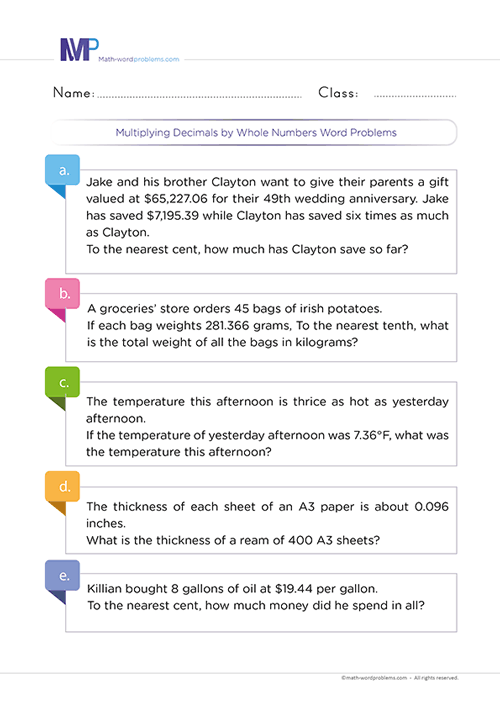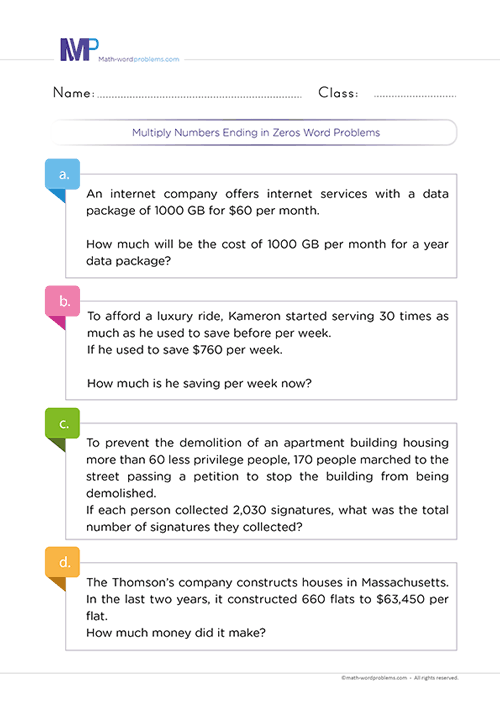 How to perform multiplication of decimals by whole numbers word problems
How to perform multiplication of decimals by whole numbers word problems
Here are excellent tips on how to perform multiplication of decimals by whole numbers word problems. These tips will guide your 5th graders through a step-by-step process of accurately solving multiplication of decimals by whole numbers problems.
Our step-by-step guide is unique as it'll promote kids' reasoning to read and understand problems easily and encourage them to explain why their answer makes sense.
Steps on word problems to solve multiplication of decimals by whole numbers word problems
As mentioned earlier, our steps on how to solve multiplication of decimals by whole numbers word problems will significantly engage learners' minds.
First, they'll be able to master the relationship between the known and unknowns when multiplying decimals by whole numbers word problems rather than just rushing to look for the final answer.
Also, after carefully going through these outstanding steps, they'll efficiently grasp all the significant strategies for solving multiplication of decimals by whole numbers word problems.
We are designing all these steps and strategies so your 5th graders can apply this knowledge and understanding to solve real-life problems requiring decimals and whole numbers multiplication.
For this reason, we will include some examples of interesting real-world problems to show grade 5 learners how to incorporate simple steps in solving real-life situations.
For instance, If it is a Multiplication Operation, you will come across one of the following keywords in a word problem: - times, multiplied by, product, product of, factor, of, multiply, times, multiple, double, triple, groups, by, twice, area, equal groups, every, in all, total, increased by, as much, each, lots of, groups of, per, etc.
Step 1: IDENTIFY THE PROBLEM
To identify the problem, you must read the word problem very carefully to know what the problem wants you to solve.
Also, try to identify important numbers and keywords in the word problem.
Note: One key Element for learners to understand is that they should not always rely on keywords alone. That is to say; the same keyword can have different meanings in different word problems
For this reason, we reiterate on the importance of reading the question very carefully to understand the situation that the word problem is describing, then figure out exactly which operation to use
Step 2: STRATEGIZE OR GATHER RELEVANT INFORMATION
How are you going to combat the problem?
One key thing you should remember is that each word problem may require a different format. So, these key points below will help kids to solve any format however it comes accurately.
- As mentioned in step 1 above, from the keyword(s) in the word problem, you can determine whether or not you need to perform a Multiplication Operation.
- However, know that you must not rely solely on keywords. Also, try to understand the situation that the problem is describing.
- Next, after knowing the operation you will perform, construct short sentences to represent the given word problem.
Step 3: CREATE THE EQUATION
Here, we will write down a numerical equation representing the information given in the word problem.
Step 4: PROVIDE A SOLUTION
From step 3 above, multiply the numbers using regrouping or other multiplication methods like long multiplication, grid multiplication, or lattice to determine the result. Always recall adding the unit of measurement to the final answer, if any.
Step 5: CHECK YOUR WORK
Lastly, check if your answer makes sense. For instance, estimate the answer and see if it is close to what you expected. However, if the answer is not what you expected, go back to step one and start all over again.
Examples on how to multiply decimals by whole numbers word problems
Example one
Step 1:The important numbers here are 31.05 and 12. Also, the most important keyword(s) found in the word problem is "times."
Step 2:Now, how are you going to tackle the problem? You see the problem's situation, and the keyword(s) call for you to perform a multiplication operation.
Next, form short sentences to represent the given word problem.
- Distance Jude covered each time he went on a hiking trip = 31.05 miles
- Number of times he went out hiking = 12
- Therefore, the number of miles he hiked last year = The distance Jude covered each time he went on a hiking trip × the number of times he went out hiking.
Step 3:Then, write down a numerical equation to represent the bolded sentence in step 2 above to solve this word problem:
31.05 miles × 12 = ?
Step 4: From step 3 above, multiply the numbers using regrouping or any other multiplication methods like long multiplication, grid multiplication, and lattice method to determine the result. Always recall adding the unit of measurement to your final result.
Using the long multiplication method, we have
Additionally, since it is the multiplication of decimals by whole numbers, we need to treat the decimal number as if it is a whole number, i.e., multiply the values as if they were all whole numbers while ignoring the decimal point.
Then, count the number of digits after the decimal in the factor with a decimal point.
Now, put the same number of digits behind the decimal in the product.
So, he hiked 372.6 miles last year.
Step 5: Finally, check if your answer makes sense. For instance, estimate the answer and see if it is close to what you expected. However, if the answer is not what you expected, go back to step one and start all over again.
Example Two
Step 1:Here, the important numbers are 17.6 and 5. The most important keyword(s) found in the word problem is "times."
Step 2:Now, how are you going to tackle the problem? You see that the situation the problem is describing and the keyword found in the word problem call for you to perform a multiplication operation.
Furthermore, construct short sentences to represent the given word problem.
- Quantity of resins in a jar = 17.9 cups
- The number of more cups of resins the cupcakes demands = 5 times as many cups of resins as the ones in the jar.
Step 3:Now, write down a numerical equation to represent the bolded sentence in step 2 above to solve this word problem:
17.9 cups × 5 = ?
Step 4: From step 3 above, multiply the numbers using regrouping or other multiplication methods like long multiplication, grid multiplication, and lattice to determine the result. Also, remember to add the unit of measurement to the final answer.
However, since it is the multiplication of decimals by whole numbers, we need to treat the decimal number as if it was a whole number, i.e., multiply the values as if they were all whole numbers while ignoring the decimal point.
Then, count the number of digits after the decimal in the factor with a decimal point.
Now, put the same number of digits behind the decimal in the product.
So, she needs 89.5 cups of resins in all.
Step 5: Finally, check if your answer makes sense. For instance, estimate the answer and see if it is close to what you expected. However, if the answer is not what you expected, go back to step one and start all over again.






